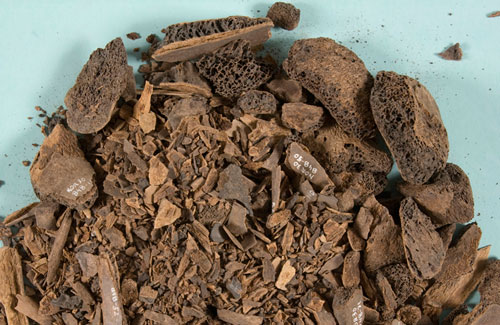Potthoff, Tanja / Robben, Fabian / Küchelmann, Hans Christian / Bittmann, Felix (2009): Die wirtschaftlichen Grundlagen eines Kleinraums am Rand der ostfriesischen Geest – frühmittelalterliche Fundstellen des Süder Hookers in Norden, Ldkr. Aurich. – Nachrichten aus Niedersachsens Urgeschichte 78, 93-119
[The economic basis of a small area on the margin of the East Frisian “geest” – Early Medieval sites at Süder Hooker, Norden, Rural District of Aurich]
Abstract
In 2007, prior to the construction of a bypass at Norden, Rural District of Aurich, East Frisia, two Early Medieval work sites and/or iron-smelting sites, which were probably only temporally occupied, were excavated there. Pottery finds date them to the 9th and 10th centuries AD. At iron-smelting site 7:46, the remains of a smelting furnace were discovered as well as the waste dumps of several others. Some two dozen round waterholes and finds of slag suggest that site “terp 30” was also connected with iron smelting. Both sites are situated in the “Süder Hooker”, an interesting area at the transition zone of the coastal marshland and the higher, dry and sandy land of the “geest”. Here we find a remarkable number of Early Medieval sites. The settlement of “Hoog Ses” on the geest has previously been excavated, in 1997. All the other sites are found on lower ground in the coastal marshland: seven terps and three sites on flat ground. There may be several reasons for the colonisation of the marshland during the 9th and 10th centuries AD: First of all, a fall in sea level began in about 850 AD. In addition, one might mention an increase in population and an economic revival after the annexation of East Frisia by the Carolingian Empire. The features of the sites on the marshland give the impression that they were only seasonally occupied.
Download (pdf 0,9 MB)


Potthoff, Tanja / Robben, Fabian / Küchelmann, Hans Christian / Bittmann, Felix (2009): Die wirtschaftlichen Grundlagen eines Kleinraums am Rand der ostfriesischen Geest – frühmittelalterliche Fundstellen des Süder Hookers in Norden, Ldkr. Aurich. – Nachrichten aus Niedersachsens Urgeschichte 78, 93-119
[The economic basis of a small area on the margin of the East Frisian “geest” – Early Medieval sites at Süder Hooker, Norden, Rural District of Aurich]
Abstract
In 2007, prior to the construction of a bypass at Norden, Rural District of Aurich, East Frisia, two Early Medieval work sites and/or iron-smelting sites, which were probably only temporally occupied, were excavated there. Pottery finds date them to the 9th and 10th centuries AD. At iron-smelting site 7:46, the remains of a smelting furnace were discovered as well as the waste dumps of several others. Some two dozen round waterholes and finds of slag suggest that site “terp 30” was also connected with iron smelting. Both sites are situated in the “Süder Hooker”, an interesting area at the transition zone of the coastal marshland and the higher, dry and sandy land of the “geest”. Here we find a remarkable number of Early Medieval sites. The settlement of “Hoog Ses” on the geest has previously been excavated, in 1997. All the other sites are found on lower ground in the coastal marshland: seven terps and three sites on flat ground. There may be several reasons for the colonisation of the marshland during the 9th and 10th centuries AD: First of all, a fall in sea level began in about 850 AD. In addition, one might mention an increase in population and an economic revival after the annexation of East Frisia by the Carolingian Empire. The features of the sites on the marshland give the impression that they were only seasonally occupied.
Download (pdf 0,9 MB)